-
A thriller needs to be able to obtain and keep hold of the audiences attention by using a fast paced story which creates suspense and tension throughout, so the audience are always on their toes. The genre is one in which producers can really explore and use all the techniques which are available to produce amazing films which are a mix of excitement and scares, a combination of feelings which make most people fascinated and enticed by what they see.When creating a thriller producers need to think of all the ways in which they can make sure they turn out a thriller which does just that.
To do this the producers need to create a sense of enigma, enigma code is when the film reveals part of the story, but leaves it unclear, so the audience are made to think about what may happen next, and are always asked constant questions. Enigma is a key technique used in thrillers because it is a great way of grabbing the attention of the viewers and creating tension. For example in our title sequence you cannot see any of the characters face's, so the viewer is wondering what they look like, who they are and what they are doing. It creates a sense of mystery, the viewer is never sure of the full identity of the characters.
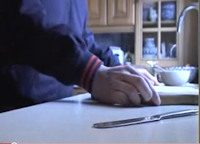
The narrative of the story is very important, the narrative is a chain of events in a cause and effect relationship, occurring in time and space, and is not a random string of events. Producers include restricted narration and unrestricted narration to again make sure the viewer always has something to think about. When narration is restricted it means that the audience only have partial access to what is going on, this links to enigma, and in a thriller it makes it that much more exciting when you as a viewer do not quite understand something yourself, because you need to work something out, and feel involved. Unrestricted narration is obviously when you are told and shown everything that is happening, a mixture of the two maybe used, for example if there is a double plot to the film, the producers may want the viewers to understand one plot, and think they are fully aware of whats happening, but then later find that there is another part of the story. But this could just be included in restricted narration. We use this in our opening because we have two characters, so the audience see two different peoples daily routines. In other words, parallel editing. The narration is restricted because we haven't told the viewers exactly what they are doing.
Mise en scene is an important part of any genre and has many sub-categories which can be tailored specifically towards a typical thriller film. For example most films include an antagonist and a protagonist. An antagonist is a villain, an evil character who the audience will see as a threat to someone else, and the producers would try and make most of the feelings towards this character full of hate. In our clip we have tried to get across two different characters personalities early on. The antagonist is the character who we see in a darkened room cleaning a knife which is covered in blood. Obviously people will see this character as someone who has done something wrong, meaning subconsciously they have labeled him as the evil character already. Naturally if there is an antagonist then there will be a protagonist, which is the opposite. Someone who will be seen as the hero of the story, and most likely be the main character, in which the creators will try and make the viewers feel very attached to this character. The term 'Binary opposition' is used to describe when there is a rivalry between two characters.
Iconography is another part of mise en scene which is the use of say objects which are particularly related to the thriller genre. Iconography is used to make it clear what the genre is, or whether a character is good or bad. For example in a typical thriller we are likely to see guns and knives, and obviously if someone was holding either a gun or a knife, straight away we assume that character is going to do something bad or wrong. This links back to what i was just explaining. To make sure the viewers differentiate between the antagonist and protagonist, we used a classic thriller prop, the knife. This is a great example of using iconography to get across a characters personality.
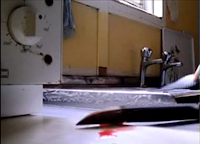
The use of the camera and the type of shots in a film help a lot to determine a thriller film. The camera is a powerful tool and when used correctly it can help a lot when making a situation more scary and exciting. In thrillers we are most likely to see close up shots in quick succession to create a more high paced scene, or we see shots which are long and out of focus, to build more tension. Camera shots together with sound are crucial to building up tension. If fast paced high tone music is used then it disturbs the viewer and keeps them on edge. Also sound can help give the audience an idea to whether something key to the story is about to happen, by building up volume and intensity. However in our opening we have used a rather upbeat jazz melody. This is deliberate because it contradicts the typical eery thriller music, and creates a sense of irony.
Common thriller themes and topics may include things like chase scenes, where a protagonist is trying to flee from an antagonist hunting them down. Or where the protagonist works to try and resolve problems which they are confronted with in the narrative.
-
In our media product we have two main characters, and the way in which these two characters are represented is very important. The protagonist in our sequence is a young male teenager, so we needed to make sure he came across innocent and careless. This also helps with him being the protagonist and the victim, because he is oblivious to what is going to happen. The clothes he is wearing suggests he is young and doesn't have a job, he isn't in a suit or anything because this would make people think he was working class. Although, we see him alone in a house, preparing his own food and getting ready to go out, suggesting he does have some independence, and is old enough to get himself in to some risky situations. Obviously in the sequence we do not see his face, and facial expression is a key part in representation, because we can read whether the character is very serious and masculine, or young and inquisitive.
The rooms in which the protagonist is featured in are all very well lit, which again suggests innocence, as darkened rooms usually connote something evil or sad. The activities that the character is partaking in are very 'everyday' for example getting a drink, putting on his shoes and bag etc. this again helps define whether the character is the protagonist or not because he isn't seen doing anything which could be related to a typical thriller topic. Unlike the other character who is cleaning up from what looks like his last attack. We have tried to make the protagonist represent young people in a positive way because we have found that in most media wether it be newspapers, magazines or the TV news channels young people are represented in a negative way. We have made sure the character does not fit the stereotypical teenage figure we have been lead to believe today, a young person is now seen to be lazy, rude and are up to no good, this is down to the media. By creating a positive image of young people it helps us target the younger audience, and i believe that thrillers are mostly viewed by people from the age of 16 to 22.
The other character in our media product very much contradicts the other. We have a man who is around 20 years old, so a bit more mature than the other. However this man is made to look very suspicious. He is wearing all black, whereas the other character was wearing brighter clothing, this suggests evil and creates the sense of mystery. We see less of this character, infact we only really see his black gloves, this helps to reinforce the fact that he is up to no good, making sure his hands are covered, meaning less evidence is left behind? Also the reason we do not see him as much as the protagonist is because this shows he has maybe even more to hide, and we don't get a clear picture as to where he is situated, meaning he could literally be hiding somewhere. This character is always seen in darkened rooms, and again is on his own like the other character, only this character doesn't seem so vulnerable. Mostly due to the fact a knife is almost always in shot. Also the character may come across as a perfectionist, because we see him cleaning, placing objects down and slowly but calmly putting on gloves, this makes the character slot into a psychopathic stereotype, someone who has to have everything perfect, and when its not their personality can flip at any moment.
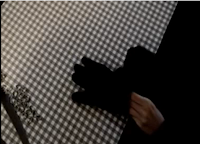
Whenever a different character appears on screen the music changes volume, one of the main reasons for this is to show the change between characters, but also it is to show a side of the characters personality and situation. For example the music is loud when the protagonist is in the picture, but as soon as we see the protagonist the volume lowers, this helps to show that he is up to no good. Also because the music is so joyful, the fact that the volume decreases connotes that this character is not the type to be so happy.
-
Together we have thought about what company we would approach if we were to distribute the film across the globe. We looked into many different distribution companies and used this website to seek advice as to how we would go about distributing a film: http://www.launchingfilms.com/index.php
We discovered that the film 'Vertigo' which is an Alfred Hitchcock production, used Paramount Pictures, and as vertigo is a very popular thriller movie, we would use the same company if we were to produce and distribute our sequence. Paramount Pictures have been involved with huge blockbuster films, which is what our film would be, and we would have plans to get the film out to all countries across the world. Titles such as the recent thriller 'Shutter Island' have been involved with Paramount which has been very successful, as well as the 'Shrek' trilogy.
Obviously we would want our film to be in all major cinemas, so we would have to do a deal with companies such as 'Vue' and 'Odeon' Another way in which we could distribute our film would be via the internet. We could have internet screenings online which would be relatively easy and cheap, it would also mean it would be easily accessible to the whole world. Also we could use a company like 'Sky' and give them exclusive rights to the film to be shown on their TV channels, and use their videos on demand service, which is already very well established. Also at the moment we are seeing adverts for Sony internet television, this could be a new innovative way of showing our film. The technology is relatively new so Sony would most likely want to let people know about their new internet TV service, so exclusivity deals could be available. Also Sony have a very strong foot in the video gaming industry, which is now becoming more of a homehub, and including on demand video and film services, so this could be an easy way of getting our film into peoples homes. Also a good example of advertising on a games console would be Lynx, promoting their new deodorant range called Lynx Twist. They made a deal with Microsoft's Xbox to expose their product to teenagers and young adults all over the world using Xbox Live. Here is an example of how movies are now available to watch on demand on video games consoles: http://www.xbox.com/en-US/live/netflix/
-
Our target audience for our film sequence would be anyone from the age of 15 to around 25 years old, as our survey produced results showing that most people within this age range would rather watch a thriller than a rom com or chick flick. Due to the fact that rom coms and chick flicks are aimed towards a more female audience, we have found that more males would be interested in a thriller, therefore we have aimed it at 15-25 year old males. This links back to how we would advertise our film using the gaming industry. Predominantly games have been designed around and aimed at young males and statistics show that more males own games consoles that females. However this is changing and more females are starting to enjoy gaming, meaning more games are being designed around them. So, by using game consoles considering our target audience i think it would be a very successful way of advertising.
We also looked into what kind of thrillers our target audience enjoyed. We did this by taking out a survey with students at our college. We asked them what was their favourite thriller at this moment, around 70% of them said 'Shutter Island' (distributed by Paramount Pictures) which you may say would be obvious because it is the biggest thriller on screens at the moment. However, we then gave them a choice of either 'Vertigo', 'Memento', 'Se7en' or 'The Birds' and 60% answered saying they preferred either 'Se7en' or 'Memento' this proves that a majority prefer more modern day thrillers. 'Se7en' has many similarities to our film sequence, because it involves a 'chase' storyline, where detectives are following a sequence of murders, and the murderer is hunting down their next victim. So the fact that the majority like this film, shows our film has potential.
-
At first the viewer is confronted with someone laying on the ground, and they look unconscious, so the viewer would then be intrigued to find out what had happened. To grab the attention of our viewers we then used quite an intense sequence of camera shots. We decided to use many close ups in quick succession to make sure the viewer was awake. I think the viewers would enjoy this because the film is asking them to think straight away. We think with have achieved an opening sequence which will make the viewer want to watch on, which is very important obviously if you want to produce a successful film. The storyline to the film has been used before in many thrillers, its a classic chase scene story where one person is the victim trying to get away from the antagonist. This would appeal to the avid thriller fan who enjoys their old basic great thrillers, but it also has more of a modern twist, which then appeals to the young people of today. We have used a wide range of camera shots to capture the viewers attention, for example we have a shot which starts off with a very shallow depth of field, which then focusses in on the subject exiting the building. Interesting camera shots like these help to attract the audience.
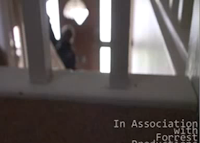
As we have mentioned before i think the protagonist character would appeal to the younger audience and would be someone they could relate to, this would help attract especially the younger generation to watch the film and follow the story to see what happens to him.
-
Throughout production of this short film clip we have learnt a lot about the new technologies involved in media and the wide variety of equipment used to aid the process. For example we used many different camera techniques to make sure we produced a good quality image. We had to always make sure the white balance of the camera was correct, and we can now see how bad the moving images look and how different the colours are when using the wrong white balance. Also I have learnt how to control the focus on a camera to create a shallow depth of field, this is very useful as it helps to create some very effective shots. Other equipment we used included a tri-pod, which i never realised how important tri-pods were until i had to create a semi professional film. Without them the camera shake makes for a rather cheap looking film. To help out with the lighting we had to use a red head. A red head is a very powerful light, we used it to help differentiate the characters in their good and bad roles. Before we could use any of this equipment we had to learn about the health and safety issues and methods in which to use it safely. When using a red head we would have to go through a procedure before turning it on, this involved shouting 'Lights On!' and 'Lights Off!' loud and clear because the lights could almost instantly blind someone in direct contact with it.
The editing software we used was very interesting, I have now learnt and realised how important editing is in the film industry and without someone who knows what they are doing or the right programs a film can look below standard. The editing software included many fades and interesting ways of grabbing the viewers attention. At the beginning of our film we have a flashback, and to make sure the viewers knew this we used a fade to white.
I think we were rather successful with our editing, I don't think we went over the top which can be easy to do. But we should have left ourselves more time as we did not realise how important the editing part of the production was. As an individual I managed to show great use of continuity editing by cutting down shots and moving parts around. As a group i think we all managed to produce a fairly good end product although we could have done a lot more differently. For example just allowing ourselves more time for editing and shooting. Also i think our idea was to original, and we could have thought more outside the box.
-
Our peer evaluation overall says the music was good and worked well because it was very contradicting. Also the use of close up camera shots apparently worked well, which i agree with, i think this was a key part in making the opening feel like a thriller. We recieved criticisms for using some shots which made the film feel like a rom com, especially when paired with the more upbeat music. I do agree to a point, but personally I don't think they have seen the point in us using the rather ironic soundtrack. Overall I am pleased with what we have come up with especially in the time we had and the fact that we had to try and organise meeting up to film, which we found quite hard. Our effort was of a high standard, especially David, he put in a lot of time especially at the editing stage because he was the only one available so close to the deadline. Chris worked well when filming, although unfortunately because Chris lives further away from the filming location than myself and David he often had to miss out on some filming.
-
I have learnt a lot since we did the preliminary task, and I am happy with the progress I have made from there. I know have a wider knowledge on how to use a HD camera to its full potential. I now also have a better eye for finding unique and interesting shots to capture the attention of the viewers. We also learnt in our preliminary to keep track of what we are filming over on the tapes because we made the mistake of filming over previous footage, so this time we took extra care. We have now moved on from iMovie to Final Cut Pro which is a much more advance editing software to what we were using for the preliminary, so every aspect of the creation process has vastly improved since we started our preliminary project. I think the preliminary is very advantageous and is a very good way of honing your skills before taking on a larger project.
-
Overall I think we did a very good job and I am pleased with the final product. We now know what we would change next time and have taken some constructive criticism.















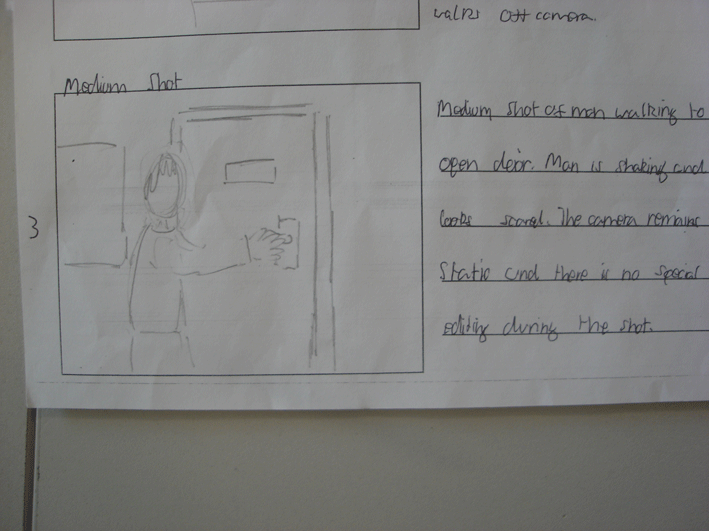















No comments:
Post a Comment